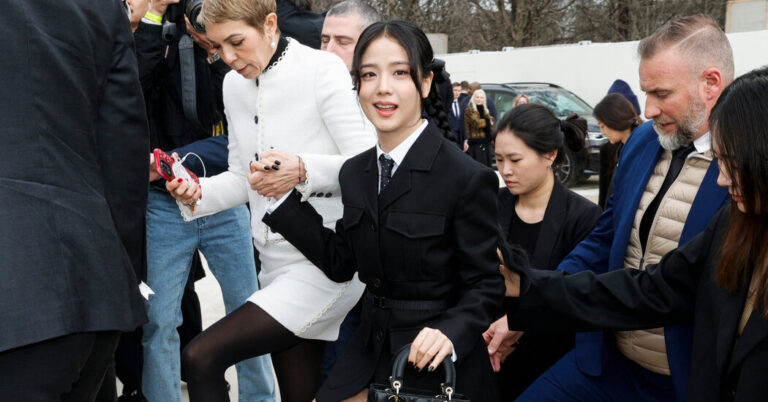When throngs of fans screamed from the guardrails outside the Paris fashion shows this season, and photographers and cellphone-wielding onlookers caused mayhem in the front rows, it was rarely a Hollywood actress or a British rock star who captured the attention. Instead, it was Asian celebrities who generated the most excitement — and online clicks — as their dominance on the fashion week celebrity circuit reached new heights.
At Dior, brand ambassadors Natalie Portman and Jennifer Lawrence watched crowds erupt for South Korean pop idols Jisoo of Blackpink and Mingyu of Seventeen, Filipino actress and model Pia Wurtzbach and Chinese singer Xin Liu, whose legions of fans wore ice blue outfits and clutched signs before following her around the city.
Chinese actress Yang Mi was perched between LVMH Fashion Group CEO Michael Burke and Loewe CEO Pascal Lepoivre. At Saint Laurent and Louis Vuitton, BLACKPINK’s Rosé and Lisa drew the loudest cheers. At Acne Studios, fans went wild for Korean-American singer Johnny Su’s shirtless appearance, flanked by J-pop star Mendy Sekiguchi and members of ILLIT, the newest band to emerge from Hive, the agency that represents K-pop artists including BTS.
Similar scenes were seen at Burberry’s shows in Milan and London, with official brand ambassadors such as Chinese actress Tang Wei, Thai actor Vachirawit Chivalry, known as Bright, and South Korean soccer star Son Heung-min all in attendance.
For more than a decade, fashion brands have been nurturing relationships with key ambassadors in China and South Korea. But Southeast Asia is growing in importance amid a stagnant North American market and uncertainty in the luxury sector. Sales in the region are expected to grow 4.8% in 2024, with Thailand set to see the most growth, driven by a local consumer base and tourists from neighboring Asian countries, according to data from consulting firm Bain & Company. Many fashion houses are now strengthening partnerships with celebrities from the region, especially stars from Thailand, Indonesia and the Philippines.
In a celebrity-obsessed world, getting the right endorsement from the right person at the right time is the most powerful marketing move a brand can make. Competition between brands to sign celebrities is becoming increasingly fierce and expensive.
“We look for people who are the best in their field, be it acting, singing or sports, and who can embody the Burberry look and aesthetic,” Burberry’s chief marketing officer Rod Manley said of the brand’s criteria for partners, adding that Asia accounts for more than a third of Burberry’s sales.
When celebrities make appearances at fashion weeks or stars post on social media wearing the brand’s products, fashion companies scrutinize online impressions and engagement, photos and content across social and traditional media platforms and geographic markets to quantify the value of their investment.
“When it comes to Asian celebrities and platforms, the numbers are astronomical and more influential than Western ambassadors,” Manley said. “Especially when there’s a new project like a TV series, the impact of being associated with a brand is multiplied.”
LaunchMetrix, a data analytics and software company that uses an algorithm called Media Impact Value to assign monetary value to posts, coverage and articles, found that Blackpink’s Jisoo’s single appearance in Dior’s show last season accounted for 14% of the fashion house’s total Media Impact Value, or $8.1 million.
That compares to $2.7 million for Western actresses like Robert Pattinson and $4.5 million for Jennifer Lawrence. (Dior declined to comment for this article.)
Alison Bringé, chief marketing officer at LaunchMetrics, said signing Asia-Pacific celebrities gives partner brands both local and global credibility, especially at a time when many shoppers are embracing expressions and cultural inspirations from outside their home countries. At fashion shows in Europe today, fans clamoring to catch a glimpse of a Korean or Thai star are as likely to be from Italy or France as they are Asian or of Asian descent, she said.
While some American stars such as Zendaya and Kylie Jenner continue to heavily influence fashion trends, Asian celebrities tend to be more experimental with their wardrobes, which makes them attractive to Western brands, Brinji said. Social media also has a huge influence on consumer behavior in Asia, with online fans often encouraging each other to buy products endorsed by their idols.
Su, of boy band NCT fame, made his Paris Fashion Week debut last week at Acne Studios, posing on a giant chair made from tires. He wore denim flares and a long biker jacket draped over his chest, with flowing black hair dyed orange at the ends. Screaming fans made it nearly impossible to get into the show.
“Johnny is a great fit for us,” a brand spokesperson said, noting that Su “embodies the androgynous spirit of Acne Studios and has a highly creative and unique sense of style.”
Burberry’s Manley added that unlike their Western counterparts, celebrities in Korea, Thailand and other Asian countries are keen to interact with fans and see it as part of their job, spending a lot of time before and after events taking selfies and signing autographs.
Asian celebrities also draw big crowds in the region, he added: “We expect it to be a big deal at fashion week, but when we open a store in Asia and invite a star, there will be thousands of fans in the mall compared to 100 people elsewhere. It’s just on a different scale.”


